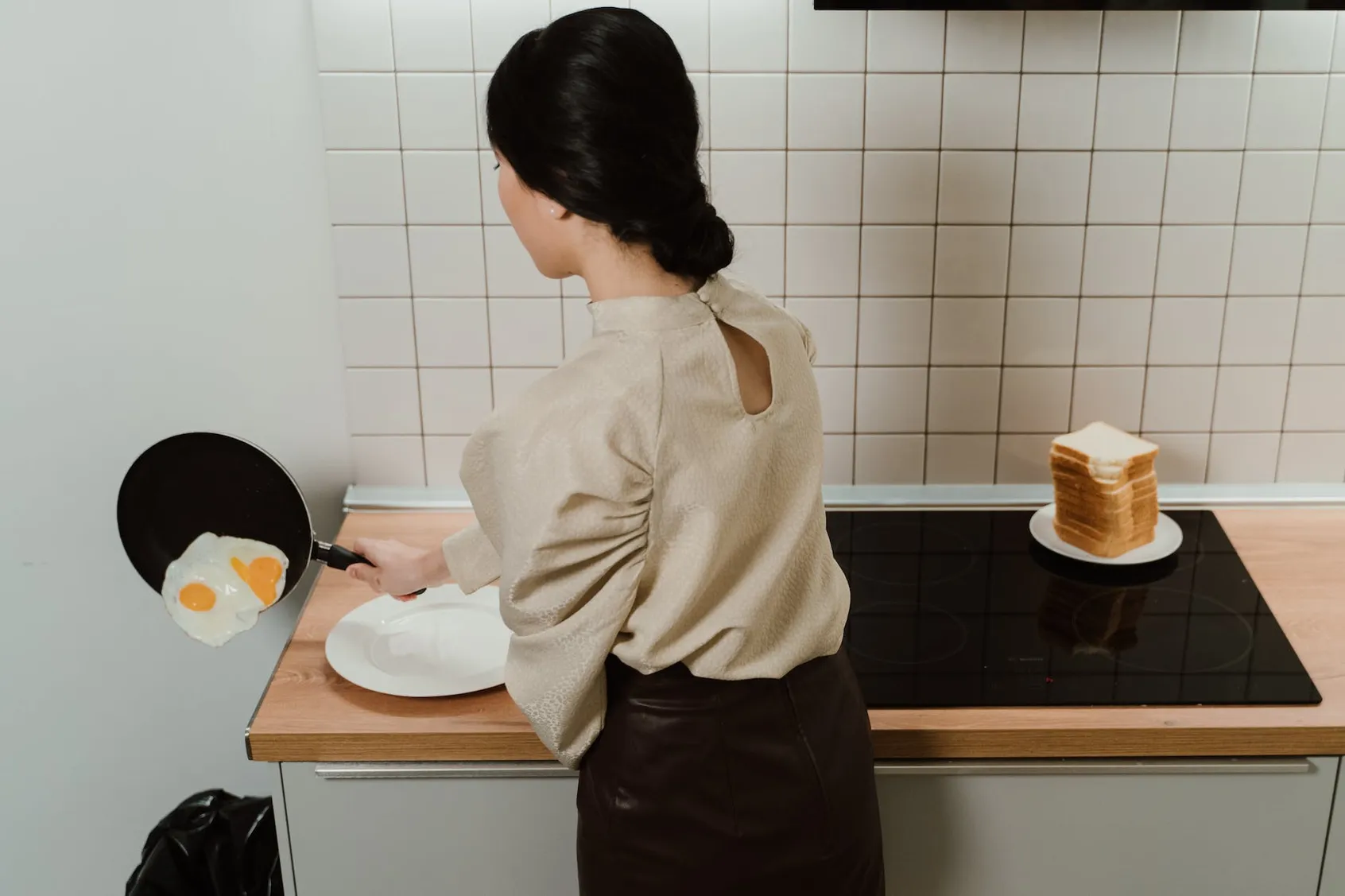Cleaning sticky kitchen tiles is a common challenge faced by many homeowners. It’s a common question they ask, how to clean sticky kitchen tiles?
Whether the sticky residue is from cooking splatters, spilled food, or other messes, it can be difficult to remove and make your kitchen look unappealing. Fortunately, several quick and easy ways to clean sticky kitchen tiles will help restore your kitchen to its original shine.
In this article, we will explore some of the best tips and tricks for cleaning sticky kitchen tiles quickly and easily.
How To Clean Sticky Kitchen Tiles?
Cleaning sticky kitchen tiles can be difficult, but it doesn’t have to be. You can quickly and easily clean your kitchen tiles with baking soda.
To start, mix a cup of baking soda with a few tablespoons of water to create a thick paste. Once you have the paste, spread it on the sticky tiles with a sponge or cloth. Let the paste sit on the tiles for several minutes, and then use a wet cloth to wipe it away.
You may need to repeat this process several times to remove the stickiness. After you have wiped away all the baking soda, rinse the tiles with clean water. Once the tiles are clean, apply a sealant to keep them from getting sticky again.
This sealant can be purchased from any home improvement store or made using a mixture of equal parts baking soda and water. Apply a thin sealant layer to the tiles and let them dry before using them again.
Cleaning kitchen tiles with baking soda is a simple and effective way to clean them and prevent them from becoming sticky again. It only takes a few minutes, and you won’t have to worry about harsh chemicals or scrubbing for hours. With just a few simple steps, you can have your kitchen tiles sparkling clean quickly.

Preparing The Tiles For Cleaning
Having the best kitchen tile cleaner is important when cleaning sticky kitchen tiles. This is because tile is porous and can trap dirt, grime, and bacteria.
The best way to clean sticky kitchen tiles is to use mild detergent and hot water to remove surface dirt. After wiping down the surface with a damp cloth, use a brush or scrubbing pad with mild detergent to remove any remaining dirt and grime. Once the tile has been thoroughly cleaned, it is important to rinse the tile with hot water and then dry it off with a clean cloth.
If the sticky kitchen tiles are stained or have a build-up of grease or food particles, it is best to use a degreaser or a mild acid cleaner. These cleaners are designed to break down grease or food particles, allowing them to be easily wiped.
Use a scrubbing pad to apply the cleaner and follow up with rinsing with hot water for best results. It is important to thoroughly dry the tile after each cleaning session to prevent any remaining residue from becoming sticky again.
If the sticky kitchen tiles have more stubborn dirt and grime, a more powerful cleaner may be necessary. A good option is a steam cleaner, which uses hot water and steam to break down dirt and grime.
This method is especially effective in hard-to-reach areas, such as grout lines and corners. After using the steam cleaner, it is important to rinse the tile with hot water and dry it off with a clean cloth.
Finally, after the sticky kitchen tiles have been cleaned, it is important to seal the tile with a sealant. This will help prevent dirt and grime from getting trapped in the tile, leading to more stubborn build-up. Sealing the tile can also help to protect it from moisture damage, which can cause it to become discolored or even cracked over time.
Using Natural Cleaning Solutions
The first step is to prepare the surface. Start by removing all kitchen items from the wall and removing any dirt or debris. Then use a damp cloth to remove grease, food particles, and soap scum. You may need a mild detergent or cleaning solution to help with stubborn spots.
Next, use a sponge or brush to scrub the tiles and grout with a cleaner designed for tile and grout. Be sure to cover all of the grout lines and corners. If you have tough spots, like grease or food particles, use a baking soda and vinegar mixture to help lift the grime.
Once the tiles and grout are clean, rinse them with a damp cloth and then dry them with a dry cloth. For a deep clean, use a steam cleaner to remove any oil and dirt that may still be present.
Finally, you’ll want to seal the grout lines and tiles to protect them from water damage and dirt. You can apply a sealant with a paintbrush or spray sealant for more even coverage. Allow the sealant to dry completely before using the surface.
Using Chemical Cleaners
Cleaning kitchen tiles can be daunting, especially when the tiles are sticky. Spills from sauces, oil, and grease can cause sticky kitchen tiles. However, cleaning them does not have to be a difficult process. You can clean sticky kitchen tiles quickly and easily with the right home remedies.
The first step is to create a cleaning solution. Mix one part white vinegar with four parts warm water. This solution will help to break down the stickiness and dirt that is stuck on the tile. Once the solution is ready, use a sponge to apply it to the tile. Scrub the tile with the sponge in a circular motion to ensure the solution can penetrate the tile.
Next, you’ll need to rinse the tile with warm water. This will help remove any remaining vinegar and dirt the solution has loosened. Once the tiles are rinsed off, it’s important to dry them off with a clean cloth.
If the tile is still sticky after the vinegar and water solution, you can use baking soda. Sprinkle some baking soda on the tiles and then use a scrub brush to scrub the tile. The baking soda will act as an abrasive and help remove any remaining dirt and stickiness. Once you’ve scrubbed the tile with the baking soda, rinse it off with warm water and dry it with a clean cloth.
Finally, you can use a natural cleaner like lemon or orange juice to give the tile an extra shine. To use this cleaner, apply some juice to a clean cloth and then rub it onto the tile. This will help to remove any remaining dirt and leave the tile looking clean and shiny.
Removing Stubborn Stains
Cleaning off grease from kitchen tiles can be a challenge for any homeowner. Grease is a stubborn substance that can be tough to remove from any surface but especially difficult to remove from tiles. Fortunately, there are some simple and effective techniques that you can use to quickly and easily clean off grease from kitchen tiles.
To start, you will need to prepare a cleaning solution. A simple mixture of warm water, dish soap, or a few drops of white vinegar will work great. Once your cleaning solution is prepared, use a sponge or soft cloth to apply the solution to the greasy tile. Allow the solution to sit briefly before scrubbing with a non-abrasive pad or brush.
You may need a stronger cleaning agent if that doesn’t remove the grease. Try using a commercial tile cleaner or a solution of warm water and baking soda. Again, use a sponge or cloth to apply the cleaner to the tile and let it sit for a few minutes before scrubbing. Be sure not to use too much pressure when scrubbing, as this could damage the tile.
If the grease still doesn’t come off, you may need to try a more powerful cleaning solution. Try a mixture of warm water, white vinegar, and baking soda. Allow the mixture to sit briefly before scrubbing with a non-abrasive pad or brush. Again, be sure not to use too much pressure when scrubbing.
Once the grease is gone, it is important to rinse the tile with clean water and then dry it with a soft cloth. This will help prevent the grease from coming back.

Preventing Future Sticky Buildup
Cleaning sticky kitchen tiles can be a hassle, but it can be done quickly and easily with the right knowledge and materials. Prevention is key in keeping kitchen tiles clean and free of stickiness.
The first step is to clean the tiles when they become dirty or stained properly. Using warm water and mild detergent, scrub the tiles with a soft bristle brush to remove all dirt and grime. Rinse the tiles with water and let them air dry.
The next step is to apply a sealant to the tiles to prevent future sticky buildup. A sealant is the best way to protect your tiles from becoming sticky due to oil and food residue. Start by applying a thin layer of sealant to the tiles. Make sure to cover the entire surface of the tile, including the grout lines. Allow the sealant to dry completely before applying a second coat.
The last step is to maintain the tiles regularly. This means wiping them down with a damp cloth after each use. This will help to remove any residual food or oil that may have been left behind. Regularly sweeping and mopping will also help keep the tiles clean and stickiness-free.
Maintaining Clean Tiles
Keeping your kitchen tiles clean is essential for your kitchen’s appearance and hygiene. Here are some tips for maintaining clean kitchen tiles:
- Start with a daily cleaning routine: Wipe down your tiles daily with a damp cloth or mop to remove spills or crumbs.
- Deep clean your kitchen tiles at least once a month: Use a cleaning solution and a scrubbing brush to remove any accumulated dirt or grime.
- Consider using natural cleaning products: Many kitchen cleaning products can be harsh and damaging to the environment. Consider using natural cleaning products like vinegar, baking soda, or lemon juice.
- Dry your kitchen tiles thoroughly: This is especially important for tiles in areas prone to moisture, like around the sink or dishwasher. Use a towel to dry the tiles thoroughly to prevent any mildew or mold buildup.
- Avoid using abrasive materials or harsh chemicals: Avoid using abrasive materials like steel wool or brushes with rough bristles when cleaning your kitchen tiles. Also, avoid using harsh chemicals that can damage your tiles and grout. Instead, use gentle cleaning solutions and a soft-bristled brush.
Cleaning Grout Lines
Cleaning grout lines is important to keeping kitchen tiles looking their best. Greasy, sticky grout lines are unsightly and can be difficult to remove. Luckily, there are several ways to quickly and easily clean grout lines. The best method depends on how dirty the grout lines are and how much time is available.
The most basic method for cleaning grout lines is a cleaning solution designed for this purpose. These solutions are usually made of a combination of water and a mild detergent or cleaner, and they can be purchased at most home improvement or grocery stores. This method is ideal for removing light dirt and grime but may need to be stronger to remove tougher stains.
Another option is to use a stronger cleaner such as bleach or hydrogen peroxide. These products are more effective at removing tougher stains but can damage the grout and tile if used incorrectly. It is important to read the label and follow the instructions carefully when using these products. Before using a stronger cleaner, it is a good idea to test it on a small, hidden area first.
For a deeper clean, a steam cleaner can be used. This method is more time-consuming but can effectively remove dirt and grime from grout lines. Ensuring the steam cleaner is not too hot is important, as it can damage the tile and grout.
Finally, a grout brush can be used for an even deeper clean. This brush is designed to scrub dirt and grime from the grout lines and can be used with a cleaning solution or on its own. This method requires more effort and time but can be very effective for removing tough stains and dirt.
Cleaning Tile Edges
When cleaning sticky kitchen tiles, the edges can be particularly tricky. Kitchen tiles, especially those around food preparation areas, are prone to grease and food particles becoming stuck to the edges. This can make them difficult to clean and lead to bacteria buildup if addressed slowly. Fortunately, there are several easy ways to clean sticky kitchen tile edges.
The first step is using a wet cloth or sponge to remove surface dirt and grease. This should remove most of the sticky residue from the tile edges. If there is any remaining residue, use a mild detergent and warm water to scrub the tiles gently. Rinse the tiles with clean water after scrubbing to remove any soapy residue.
For particularly stubborn stains, use a more potent cleaning solution. Mix equal vinegar and warm water and scrub the edges with a soft brush. This should help loosen any stubborn stains. Once the tiles are clean, rinse them with clean water to remove any vinegar residue.
You may need slightly harsher chemicals for even more stubborn stains. A good option is to use a mild bleach solution. This should help break down any remaining sticky residue. Rinse the tiles thoroughly with clean water after using the bleach solution to prevent further damage to the edges.
Finally, apply a sealant to the edges to help keep your kitchen tiles clean and grease-free. This will create a protective coating that will help keep the edges clean and free of sticky residue. Be sure to reapply the sealant every few months to ensure your kitchen tiles remain clean and grease-free.

Minimizing Odor
There are several ways to minimize odors in the kitchen. Here are a few tips:
- Clean regularly: Keeping your kitchen clean is one of the easiest ways to prevent bad smells from building up. Make sure to clean up spills, wipe down counters, and wash dishes daily.
- Use an exhaust fan: Turn on your fan whenever you’re cooking to help remove any cooking odors from the air.
- Open a window: If you don’t have an exhaust fan, opening a window can help circulate fresh air and reduce lingering smells.
- Use natural odor absorbers: Baking soda and activated charcoal are both natural odor absorbers that can help remove bad smells from the air. Place a baking soda or activated charcoal bowl in your kitchen to help neutralize any odors.
- Be mindful of what you cook: Certain foods are more likely to create strong odors, like fish and onions. If you’re concerned about odors, avoid cooking these foods or cook them outside if possible.
Caring For Tiled Surfaces
Taking care of tiled surfaces in the kitchen is relatively easy and straightforward. Here are some tips:
- Wipe up spills and messes promptly to prevent staining and moisture damage. This is especially important if you have grout between your tiles, as grout is prone to staining.
- Use a pH-neutral cleaner and a soft cloth or sponge to clean your tiles. Avoid harsh chemicals and abrasive cleaning tools like steel wool, as they can scratch or damage the tiles.
- For grout, baking soda, and water can effectively remove stains and buildup. Apply the mixture to the grout and scrub gently with a brush.
- Seal your grout every few years to protect it from stains and water damage. You can find grout sealers at your local hardware store or online.
- Finally, consider using mats or rugs in high-traffic areas to protect your tiles from wear and tear.
How To Clean Greasy Kitchen Wall Tiles?
Cleaning greasy kitchen wall tiles may seem daunting, but it can be done easily with the right materials and technique. Here are some steps for cleaning greasy kitchen wall tiles:
- Start by removing any loose dirt or grime with a dry cloth or sponge.
- Mix equal water and vinegar in a bucket or container.
- Dip a sponge or cloth in the mixture and scrub the greasy tiles, starting from the bottom and working your way up.
- Use a scrub brush for tougher stains or grime.
- Rinse the tiles with water and wipe them with a clean, dry cloth.
Alternatively, you can use a store-bought grease cleaner or a mix of baking soda and water for extra-tough stains. Remember to wear gloves and protective eyewear, open windows for good ventilation, and test any new cleaning product on a small area first.
How To Clean Kitchen Wall Tiles Easily?
Cleaning greasy kitchen wall tiles can seem like a daunting task, but there are a few easy methods you can try to get rid of the grease and restore the cleanliness of your kitchen walls:
- Use vinegar and water solution. Mix equal parts of white vinegar and water in a spray bottle and spray the solution onto the greasy tiles. Allow the solution to sit briefly before wiping it off with a clean cloth or sponge.
- Try dish soap and warm water. This is a great option if the grease is light enough. Mix a small amount of dish soap with warm water and use a sponge to scrub the tiles. Rinse the tiles with clean water when you are done.
- Use baking soda and water. Mix baking soda and water paste and apply it to the greasy tiles. Allow the paste to sit for a few minutes before wiping it off with a clean cloth or sponge.
Always test a small area before cleaning the entire wall to ensure that the cleaning solution doesn’t cause any damage to the tiles.
How To Clean Kitchen Tiles With Vinegar?
To clean kitchen tiles with vinegar, follow these steps:
- Mix equal parts of water and vinegar in a spray bottle.
- Spray the solution on the tiles, ensuring that they are soaked in the solution.
- Let the solution sit for around 10 minutes. This will give the vinegar time to break dirt or grime on the tiles.
- Scrub the tiles with a scrub brush or a toothbrush to remove any remaining dirt. Make sure to scrub all the edges and corners.
- Rinse the tiles thoroughly with clean water.
- Wipe the tiles with a dry cloth or towel to remove any remaining water.
Using vinegar to clean your kitchen tiles is an inexpensive, eco-friendly, and effective way to keep your kitchen hygienic and sparkling clean. If you find the smell of vinegar too strong, add a few drops of essential oil to the spray bottle before cleaning the tiles.
Conclusion
In conclusion, cleaning sticky kitchen tiles can be difficult and time-consuming, but it doesn’t have to be. Using the right cleaning products and following simple steps, you can quickly and easily remove sticky residue and keep your kitchen tiles looking new. You can quickly have clean, sparkling kitchen tiles with some elbow grease and the right tools.
Frequently Asked Questions:
How do you remove stickiness from tiles?
You can use warm water and mild detergent to remove stickiness from tiles. Gently scrub the area using a soft cloth and rinse with clean water. You can use baking soda and water for tough spots and scrub the area with a soft brush. Rinse with clean water afterward.
What is the easiest way to clean kitchen wall tiles?
The easiest way to clean kitchen wall tiles is to use a mild detergent or soap mixed with warm water and wipe the tiles down with a soft cloth or sponge. For tougher stains, you can use baking soda and water paste and scrub it onto the tiles with a brush. After scrubbing, rinse with warm water and wipe the tiles with a clean cloth.
What is the best cleaner for kitchen wall tiles?
The best cleaner for kitchen wall tiles depends on the material of your tiles. A gentle, pH-neutral cleaner is best for ceramic or porcelain tiles. Use a stone cleaner specifically formulated for your tile for natural stone tiles, like marble or granite. For glossy tiles, an all-purpose cleaner should do the trick. A paste of baking soda and water may be needed for tougher stains.
How do you remove cooking grease from tiles?
You can use warm water and detergent to remove cooking grease from tiles. Start by wiping the tiles with a damp cloth to remove excess grease. Then mix a few drops of liquid dishwashing detergent with warm water and use a sponge to scrub the tiles. Rinse the tiles with clean water and dry them with a soft cloth.
What is the best way to clean sticky kitchen tiles?
Mixing a warm water solution and mild dish soap is the best way to clean sticky kitchen tiles. Then, use a non-abrasive sponge or rag to scrub the tiles, and rinse them off with clean water afterward. Additionally, you can use a multi-surface cleaner or a vinegar and water solution to remove any remaining stickiness.
How do I prevent sticky kitchen tiles in the future?
To prevent sticky kitchen tiles in the future, make sure to regularly clean and seal the tiles. Start by cleaning the tiles with mild detergent and warm water. Rinse the tiles with clean water and dry them with a soft cloth. Then apply a sealant to the tiles to protect them from dirt and grime. Reapply the sealant every six to twelve months to ensure effective protection.
How often should I clean my kitchen tiles to avoid stickiness?
You should clean kitchen tiles at least once a week to avoid stickiness. You should also mop the floor at least once a month to keep the tiles clean and free of dirt or dust.
Are there any special cleaning products I should use for sticky kitchen tiles?
Yes, a few special cleaning products are designed for sticky kitchen tiles. These products can usually be found at hardware stores or in the cleaning aisle of most supermarkets. Many of these products contain degreasers, detergents, and other special ingredients designed to break down and remove stickiness from kitchen tiles.
